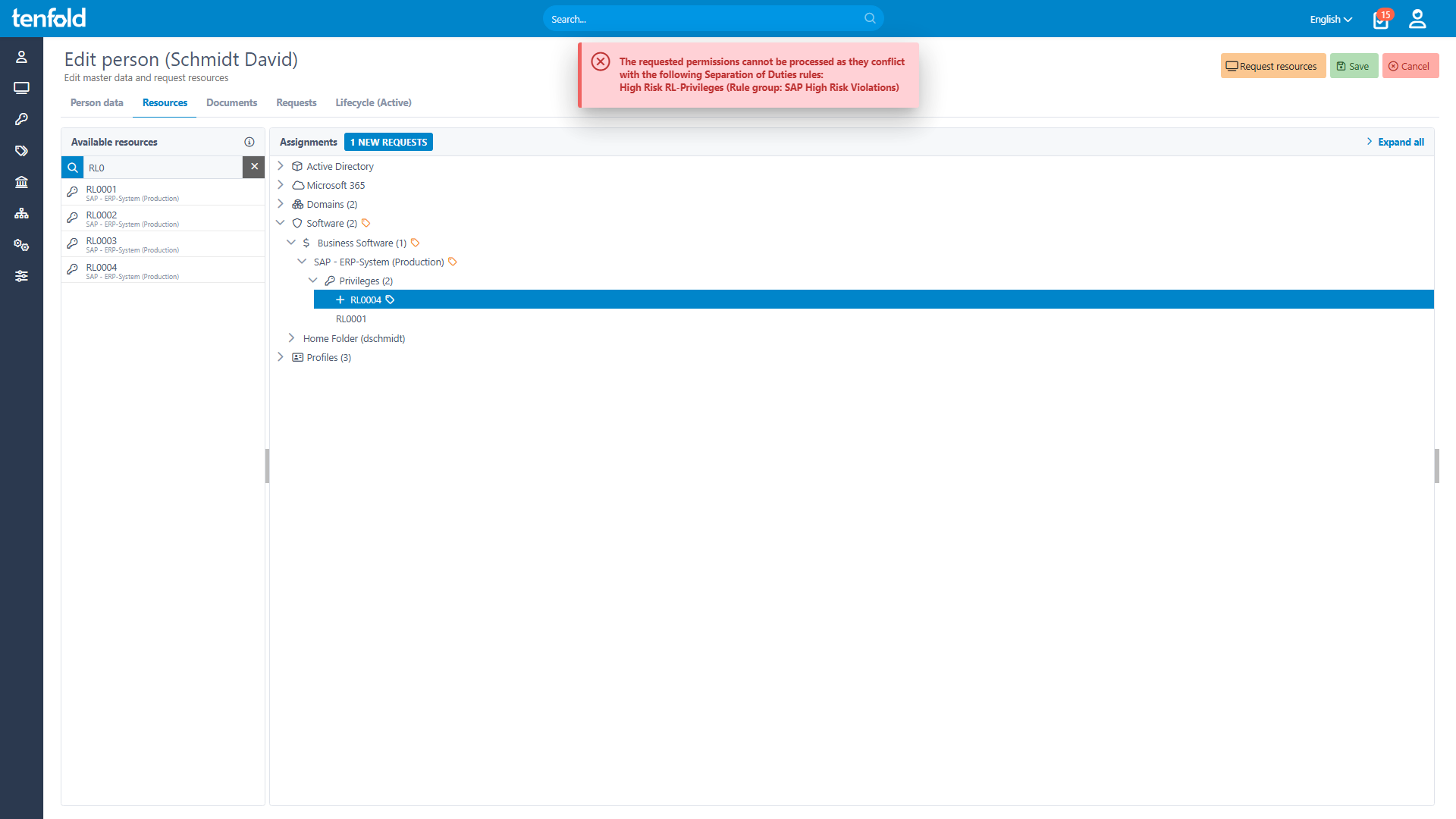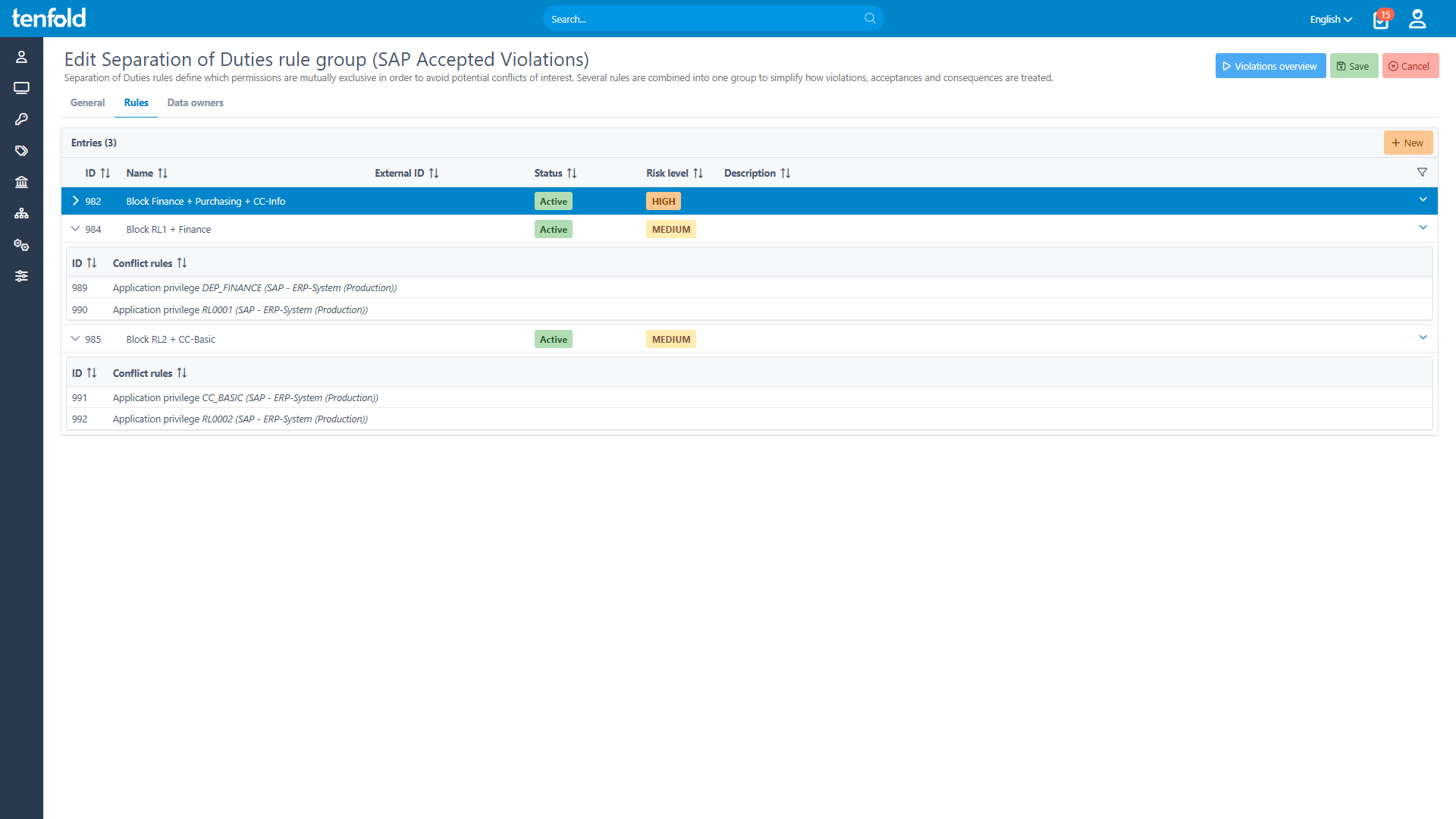Identify & Stop Privilege Conflicts
Separation of Duties is an internal control that prevents users from holding privileges that could enable fraudulent behavior when entrusted to a single person. tenfold allows you to tag conflicting privileges, automatically blocking them from being assigned the same user.
Achieve Compliance Effortlessly
From SOX to NIST, many regulations require orgs to govern access based on principles like Separation of Duties and Least Privilege. To achieve compliance and stay audit-ready, organizations need modern solutions to streamline governance and minimize overhead.
Ensure Independent Controls Across All Apps
Both within and across different IT systems, impartial oversight is essential to prevent fraud and misuse.
With the ability to set SoD rules and automate enforcement, tenfold helps you stay secure and compliant.
Set Rules
Create & customize rules as needed
Target any combination of privileges
Simulate outcomes before you go live
Tag Privileges
Tag privileges for easier targeting
Automate tagging based on name
Use tags to customize enforcement
Block Conflicts
Stop assignment of conflicting privileges
Identify existing conflicts on rule creation
Offer temporary exceptions w/ approval
Customizable Rules
Create and adjust SoD rules to target single, multiple or specific combinations of privileges. Set consequences for rule violations and test new rules with simulations.
Easy Tagging
Apply tags to more easily target privileges with SoD rules. Set tags manually or automate tagging based on resources/group name. Use tags to customize approval workflows and other processes.
Automated Enforcement
Block conflicting privileges from being assigned. Detect and remediate existing rule breaks. Choose flexible enforcement levels such as temporary access with stakeholder approval.
%
75
Lower IT Workload
%
95
Faster Access Provisioning
%
98
Recommendation Rate on Capterra
%
100
Privilege Creep Reduction
Why Choose tenfold?
tenfold’s quick setup, easy configuration and powerful features make it the ideal choice for anyone looking to securely manage user accounts and IT privileges. Our all-in-one solution combines identity and data access governance into one convenient and user-friendly package.
Download our IAM Comparison
Ready to Try It Yourself?
Cloud Demo Environment
We give you acces to a cloud environment prepopulated with users and a ready-to-go tenfold instance.
Start testing right away
Enjoy our no-code UI and easy config
Try our automated workflows in a sandbox environment with prebuilt users & groups
Full access to all of tenfold’s features
7 day trial period
Proof-of-Value Installation
Our consultants help you set up tenfold on your network so you can test it against your own infrastructure.
In-depth test in your own IT environment
Try our no-code plugins and integrations
Turn your demo install into a real deployment (No lost work!)
Full access to all of tenfold’s features
30 day trial period
Frequently Asked Questions
The Separation of Duties feature covers all resources and privileges managed through tenfold. This includes app permissions, group memberships, access to local or cloud files and any custom resources you create within tenfold, which can be mapped to Active Directory groups.
Let’s assume there are ten permissions in App A and each of them conflicts with ten permissions in App B. In other solutions, this would force you to create 100 different rules to cover every combination from 1A to 10B.
In tenfold, you could solve this problem with a single rule by applying one tag to the first group, another tag to the second and marking these tags as in conflict. As you can see, this drastically streamlines the process. Tags can either be assigned manually or based on app/group names, allowing them to be applied quickly and easily.
tenfold regularly scans managed systems to detect and sync back any changes that happened directly in the system. If it detects a change that breaks an existing SoD rule, it will flag the issue, alert you and apply any automated actions you have set for this rule.
When you create a new SoD rule, you can decide how tenfold should respond to a rule violation. There are three basic options:
1) Accept risk: tenfold will inform you of the rule break, but allow the user to keep conflicting privileges regardless. This can be useful to test new rules or if you only want to be notified.
2) Temporary approval: tenfold flags the rule break, but allows the assigned stakeholder to grant a temporary exception. If approved, tenfold will assign the conflicting privilege for the intended period of time and then revoke it automatically. This can be useful to ensure normal operations while one or more team members are unavailable.
3) Revoke access: tenfold blocks the conflicting privilege from being assigned. If a rule is created or updated and tenfold detects existing rule breaks, stakeholders will be notified and required to select which of the conflicting privileges users should lose.
Take the Next Step
See tenfold in Action With Our Feature Video
Schedule a Live Demo With One of Our Experts
Put tenfold to the Test With Our Free Trial!


